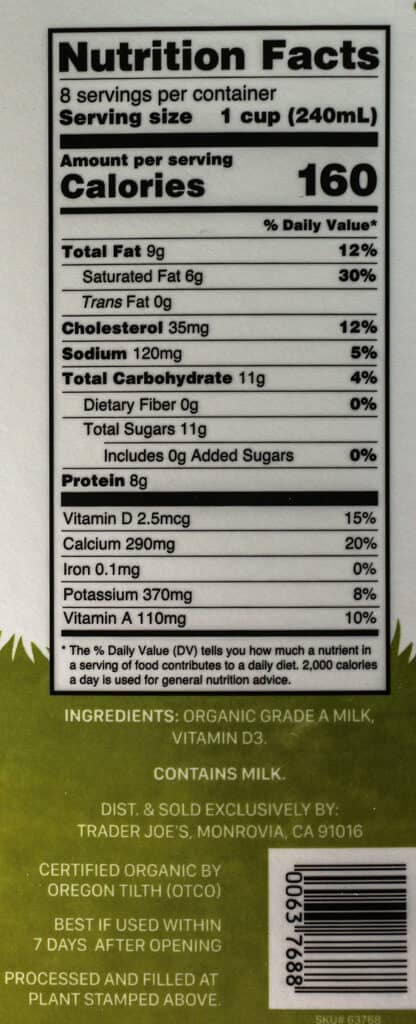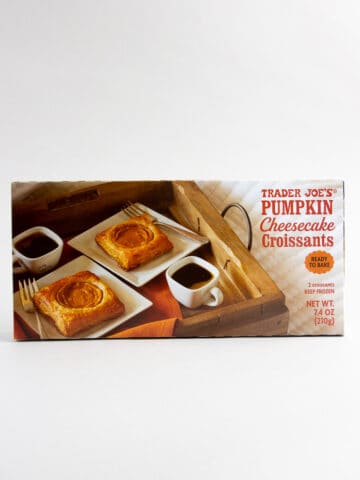It's not often that I review things as basic and a half-gallon of milk. Normally, I wouldn't. But this product jumped out to me on a few different levels. First, it's organic and grass-fed (all buzzwords right now) AND for the price. Second, this half-gallon set me back nearly $5 and that is a premium beyond the price of a regular half gallon and even the organic half gallon.

Types of milk
Now just to be clear, here is how milkfat correlates with how it is labeled in the US. In order for it to be:
- Heavy Cream-it must be 36% fat
- Light Cream- it must be 30% fat
- Half and Half- it must be between 10.5% and 18% fat
- Whole Milk- it must be 3.25% fat
- Reduced Fat Milk- it must be 2% fat
- Low Fat Milk- it must be 1% fat
- Skim Milk- can be between 0% and .5% fat (and still be labeled as fat free)
Now, this is just north of the whole milk fat level, but not out of range. It's actually closer to the UK's definition of Whole milk as they allow is 3.6% fat.
Well regardless, this is some creamy milk. The quality is all there.
Taste and review
So what would justify the price tag? According to American Dairy Association, Grass-Fed Cows produce more fatty acids which in turn could protect you from certain cancers. Plus, there are more Omega-3s. However, research in this area is emerging in this area plus to see a benefit, many people aren't consuming it in the amounts needed to perhaps make a difference. So while the research isn't conclusive, it is something to consider.
So the choice remains with the end consumer as to how to spend your dollars.
For the amount of milk, my household consumes I'm willing to pay the premium. I found this milk to be creamy and delicious. And the fact that this seems to be a substantially healthier product makes me willing to shell out the extra dough.
The fact that this is ultra-pasteurized makes storing an extra half gallon even easier as the expiration date is much further away than most conventional milk options.
Overall
For $4.99 if you can stomach the price, then this is a great buy as it's delicious and super creamy, plus the expiration date allows for more flexibility.
The price is lower than many competitors and this has become a regular purchase in our household
Did you try it? Let me know what you think in the comments section!
Product photos
The container of Trader Joe's Organic Milk from Grass-Fed Cows:

Calories and ingredients

How Trader Joe's describes this product:

Want to see more items I've reviewed from Trader Joe's? Click on Thoughts & Reviews of Trader Joe’s for a searchable list.
Trader Joe's Organic Milk from Grass Fed Cows

Product Name: Trader Joe's Organic Milk from Grass Fed Cows
Product Description: Trader Joe's Organic Milk from Grass Fed Cows is higher fat milk from cows who only eat grass.
Price: $4.99
Summary
Trader Joe's Organic Milk from Grass Fed Cows is premium milk at a premium price
-
Taste
-
Value
-
Worthy of Repurchasing
Pros
- Rich, creamy taste
- Ultra pasteurized so it will be able to sit in the refrigerator a bit longer
- A healthier milk in general according to the research.
Cons
- Price. While not out of line with most organic from grass fed cow milk competitors this is sold at a premium price.






This has become our go to milk for our home made yogurt. It comes out great.
Thanks for sharing Juan! Did you notice they now have a 2% option too? Thanks for stopping by!
I was hoping to use it to make butter. I never did this before. Is it doable? And is it considered raw?
Hey Joan! Butter you'll need heavy cream, not milk. This isn't raw. It's ultra pasteurized. Thanks for stopping by!